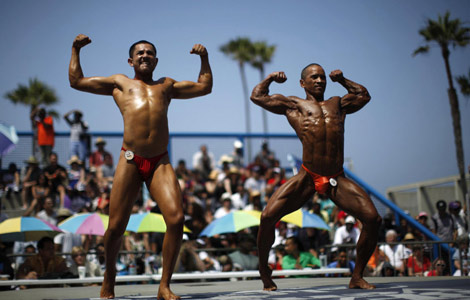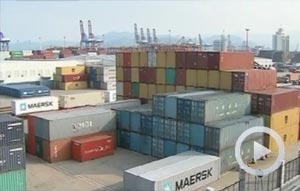When kung fu meets hip-hop
Updated: 2013-07-05 11:38
By Caroline Berg in New York (China Daily)
|
||||||||
|
Participants in the New York Asian Film Festival in New York this week. Photos Provided to China Daily |
|
One of the pieces of art in Kung Fu Wildstyle, an exhibit celebrating the life and legacy of Bruce Lee. |
Bruce Lee is respected worldwide for his legendary kung fu prowess. But art curator Sean Dinsmore was shocked to discover there was no Bruce Lee museum when he was in Hong Kong.
"That just blew my head away," Dinsmore said. "I grew up thinking Bruce Lee was a superstar. I mean everyone knows he was an international icon."
Dinsmore introduced New York hip hop godfather and street artist Fab 5 Freddy to Hong Kong graffiti artist and hip hop pioneer MC Yan, and he commissioned them to produce a Bruce Lee-centric art exhibit.
The vibrant artworks in Kung Fu Wildstyle, which use original Bruce Lee film imagery, examine the influence of the Hong Kong icon and kung fu on 1970's New York street culture and its emerging hip hop scene, as well as how hip hop influenced a generation of Hong Kong youth in the 1990's.
"Every kid I knew [growing up] wanted to do some kind of kung fu," Brooklyn native Freddy said. "At the same time in the '70s, something called hip hop was in its early stages of development."
Artists Freddy and Yan met with Dinsmore at Lincoln Center this week to discuss Lee's pop culture influence in Hong Kong and New York after they presented their Wildstyle exhibit and before a special 40th anniversary screening of Lee's legendary crossover hit, Enter the Dragon, as part of the New York Asian Film Festival.
"It was new information for me and [Freddy] that [Lee] was kind of this outlaw image in Hong Kong," Dinsmore said, learning from Yan that the kung fu legend maintained a mixed and checkered legacy among the cultural elite in Hong Kong. "Hip hop culture, even as mainstream as it is, also has this kind of outlaw image."
Freddy and Yan each produced five original works before they met for the first time last fall for a weeklong pop-up show in Hong Kong. From there, the exhibit traveled to Shanghai. Now, Wildstyle is on view during film festival in the Furman Gallery at Lincoln Center's Walter Reade Theatre.
Freddy said his first memory of Lee was seeing him in the Green Hornet TV series as Green Hornet's sidekick, Kato.
"As a young kid at the time, you'd watch Batman and Robin, but then Bruce Lee, Green Hornet and Kato were just a whole other thing that was so cool," Freddy said. "It was the first time we really got to see good kung fu, without knowing anything about it."
Freddy said the kung fu movie craze began soon thereafter and he would go to Times Square for the thrill of Lee.
"This phenomenon swept over every part of urban New York City to go see these movies, these new moves, just to get this peak at ancient China," Freddy said. "As a kid, I used to really think the dudes could fly around like that."
Freddy said people began emulating Lee's swagger and attitude.
"Breakdancing was probably a direct outgrowth of the kung fu phenomenon," he said. "These amazing crews would battle each other with incredible moves that mirrored different kung fu schools."
The golden age of kung fu filmmaking in Hong Kong was from 1971 to 1985, according to Eric Pellerin, who attended the film festival event and is writing an 80-page thesis on this topic for the City University of New York.
Pellerin said film directors during this time, including Yuen Wo Ping, Jackie Chan, Sammo Hung and Lau Kar Leung, all showcased the kung fu actors' real and fullest abilities onscreen using long shots with 30-40 kung fu moves executed in each shot. Pellerin, who is trained in breakdancing and Chinese martial arts, said this method of filmmaking has mostly died out.
"I think it is important to preserve the practice of producing Hong Kong kung fu films because it is Hong Kong cinema's unique gift to the world," Pellerin said. "It is a genre that has had an impact not only in Hong Kong, but also inspired hip hop culture in many ways."
Eventually, the hip-hop movement in New York made it back to Hong Kong in the 1990's.
While studying art in France, Yan was exposed to graffiti and hip-hop culture. Back in Hong Kong in 1997, he joined a hip-hop group, LMF, which broke barriers in Hong Kong and Asia with their outspoken lyrics and style.
"LMF was hugely popular and very much renegade and underground," Dinsmore said. "They talked about the government and they said things that were very naughty for Hong Kong kids in the '90s."
Yan said he was inspired by how Lee broke tradition and, instead of adhering to thousands of years of martial arts philosophy, he created a new school with his own format. This pioneering behavior encouraged him to study hip hop, in which Yan said young people would meet to discuss their opinions or aspirations through this new music and dance format.
"All these young people are very hungry for new culture," Yan said about today's hip-hop environment in China. "Hong Kong has taken on the role of translator and interpreter for introducing hip hop to [the Chinese mainland]."
carolineberg@chinadailyusa.com
(China Daily USA 07/05/2013 page11)

 Kobe Bryant reportedly has highest net worth in NBA
Kobe Bryant reportedly has highest net worth in NBA
 Chinese fleet arrives in Vladivostok for drills
Chinese fleet arrives in Vladivostok for drills
 Joey Chestnut wins 7th contest with 69 dogs
Joey Chestnut wins 7th contest with 69 dogs
 Lisicki, Bartoli to vie for new Wimbledon crown
Lisicki, Bartoli to vie for new Wimbledon crown
 Muscle Beach Independence Day
Muscle Beach Independence Day
 Tough workout for Li Na in war of words
Tough workout for Li Na in war of words
 Submersible taps mineral deposits in S China Sea
Submersible taps mineral deposits in S China Sea
 Ecuador finds spy mic for Assange meeting
Ecuador finds spy mic for Assange meeting
Most Viewed
Editor's Picks

|

|

|

|

|

|
Today's Top News
Missouri govt's veto won't stop Smithfield deal
Canadian potash deal shows trend among Chinese
Asian Americans more upbeat on home finances
Mandela on life support, faces 'impending death'
ROK to discuss Kaesong normalization with DPRK
Gunman shoots two, commits suicide in Texas
Baby formula probe to shake or reshape industry?
Passenger detained over bomb hoax in NE China
US Weekly

|

|








